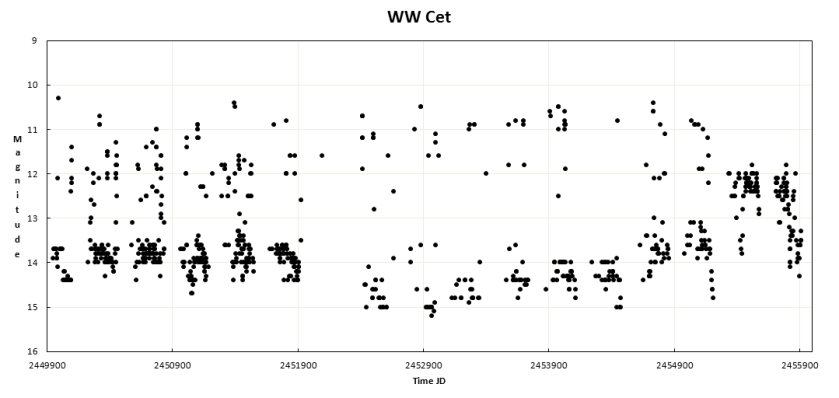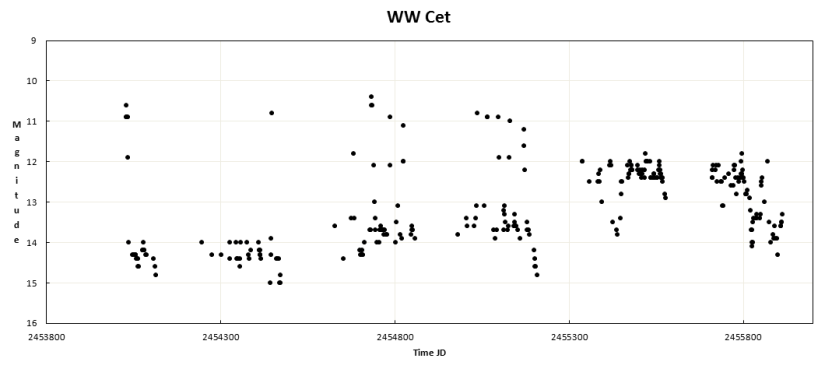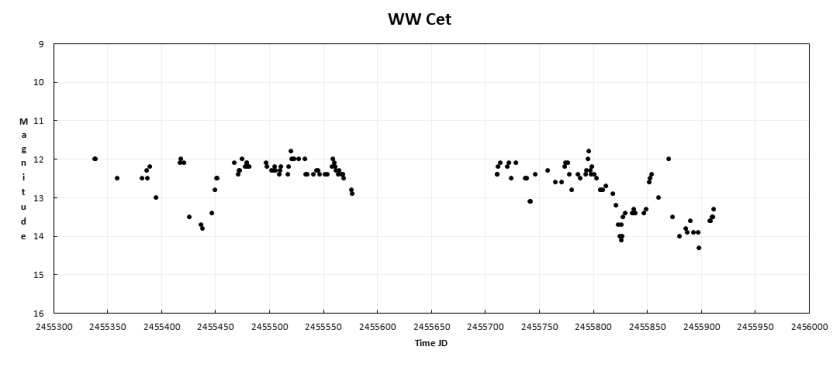WW Ceti was first mentioned as a variable star by Luyten (1962), who already suspected its CV nature, which was later confirmed by Herbig (1962). Paczynski (1963) first published a light curve but could not identify any periodic features. He was also the first to suggest the possibility that the system belongs to the subclass of the Z Cam stars. The system was included as a Z Cam star in the General Catalogue of Variable Stars (GCVS, Kukarkin et al. 1969)
Long-term visual data from the Variable Star Section, Royal Astronomical Society of New Zealand can be found in Bateson & Jones (1979), Bateson & Dodson (1985), Bateson (1985) and Bateson & McIntosh (1984-1990). Conclusions gave a probable mean period of 30.70 days.
Warner (1987) and Ringwald et al. (1996) concluded the long-term light curve behaviour of WW Cet is not typical of the Z Cam subclass.
WW Cet is a system whose classification is still uncertain. Although classified as a U Gem type system, others suggest a Z Cam classification. Z Cam systems are characterized by prolonged states of intermediate brightness between quiescence and outburst called “standstills.” Others propose that WW Cet forms a link between Z Cam and VY Sculptor nova-like variables. The latter are systems that drop unpredictably into very low brightness states but spend most of their time in outbursts. However, without conclusive evidence of standstills, we tentatively classify WW Cet as a U-Gem type dwarf nova.
The light curve below details my visual observations of WW Cet from August 1995 to December 16, 2011, observing season. The extreme visual range of WW Cet is 10.3 to 15.2. The faint peaks look to be oscillations which I believe are a feature of WW Cet.

The First Historical Standstill
My first observations of WW Cet in the 2010 season showed unusual behaviour with the star around 12th magnitude on May 21. Observations in June and July also showed the star was at 12th magnitude. On August 29, the star dipped briefly to magnitude 13.8. From September 10 to December, WW Cet has remained bright, fluctuating between magnitude 12.0 and 12.4.
WW Cet has entered into its first-ever recorded standstill! From the detailed light curve below, the standstill can be clearly seen. If you count the first observation in May, the number of days is 237. From September 10 onwards, there is no doubt that WW Cet remained in the 12.0 magnitude range for the 2010 season. After the usual seasonal gap, the 2011 observations are shown to December 16.

Standstill continues in 2011
The first observations of WW Cet in May and early June 2011 have shown the star still around 12th magnitude, which indicates the standstill has continued! From my visual observations, a more detailed look at the 2010 and the current 2011 observations. The seasonal gap is obvious when WW Cet is unobservable.
It appears that from September 16, 2011, WW Cet has dropped to a magnitude range of 14.0 to 13.4, could this standstill be over? Further observations will be posted as the season progress.
Light curve to December 16, 2011.

Co-authored paper on the First Historical Standstill.
The First Historical Standstill of WW Ceti arXiv:1012.1545
Back to Light curves
